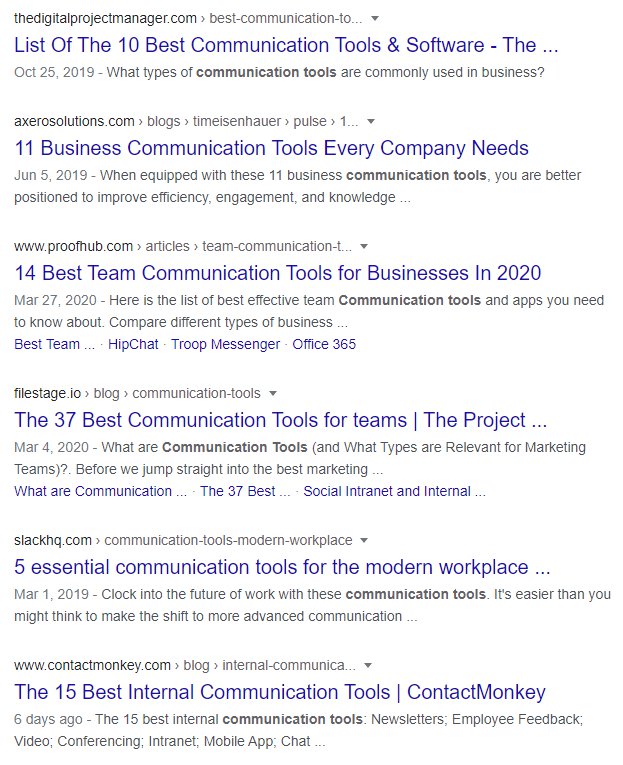Question for you:
Do you know why there are so many different types of communication tools?
I mean, just google the word “communication tools”, and you’ll find list upon list upon list of “best communication tools for teams and businesses”

It’s because communication amongst teams is both hard AND critical to the success of every business.
You would have thought we’d figured this all out by now.
And for remote teams, communication is both 10 times more important and more difficult than for their in-office counterparts.
When established companies “go remote” for the first time communication is the #1 obstacle that they need to address and overcome if they are going to make it.
In this post, we’re going to discuss the unique challenges of communication for remote teams, asynchronous communication vs synchronous communication and finally the tools that we use that will allow you to do both.
The challenge of communication for remote teams

In a typical office environment, if you have a question for human resources, you can simply walk down to the hr department, ask your question, ask a follow up question, and be done in 5 minutes.
So, the sequence of questions can look like this:
You: Hey, I was wondering how hiring for the junior developer position is going.
HR: Good, I have a few applicants that seem qualified. Is there a specific programming language that you need an emphasis on?
You: Yes, Python
HR: OK, Here’s the list of qualified candidates who specialize in python.
You’re in, you’re out, and you’ve got your list of candidates to sort through.
Now, how does this play out in a remote team like Time Doctor?
Me (in New Jersey): Hey, I was wondering how hiring for the junior developer position is going.
Wait until next day
HR (in Philippines): Good, I have a few applicants that seem qualified. Is there a specific programming language that you need an emphasis on?
You: Yes, Python
Wait until next day
HR: OK, Here’s the list of qualified candidates who specialize in python.
Why am I waiting until the next day?
Because if I send my email at 10 AM, HR won’t get it until 12 hours later, and then when HR responds, I’ll be asleep and won’t read the email until the next morning.
In this realistic scenario, which plays out every day at Time Doctor, each response can take up to 1 full day to process.
So the 5 minute conversation that you could have in an office, can take 2 full days to complete.
The difference between synchronous and asynchronous communication
In the example above, the inter-office conversation is called synchronous communication and the email conversation is called asynchronous communication.
Let’s quickly define the two:
Synchronous Communication: This is real time communication, either face to face, on the phone, etc. where all participants are present for the conversation at the exact same time.
Asynchronous communication: This is communication that doesn’t happen in real time. The participants of the conversation contribute in their own time, when it is convenient for them. Think about email, texting, and things like that as forms of asynchronous communication.
And while it may not sound like it, both forms of communication have their pros and cons.
Pros of synchronous and asynchronous communication

Here’s some of the advantages of each form of communication:
Synchronous communication
- Simple conversations can be resolved in minutes
- You can have a deeper, richer conversation. You can ask follow up questions, analyze the tone of the other person’s voice, or if in person, analyze their body language.
- You can get a feel for context and build empathy for the person with whom you’re communicating with.
Asynchronous communication
- You aren’t interrupted doing deep work. For instance, right now, as I’m writing this blog post, I know that I won’t be interrupted by a colleague knocking on my door.
- You can think through a response more thoroughly because a person isn’t waiting for an immediate response.
- Makes communicating with people all over the globe possible.
Cons of synchronous and asynchronous communication
And as you may have guessed, there are some drawbacks to each form of communication.
Synchronous communication
- You might interrupting someone while they’re in deep work
- If you’re a remote team, your time zones might not align and you’re forced to meet at inconvenient times.
Asynchronous communication
- Conversations can take days to get resolved.
- You don’t want to have super important conversations via email.
- There can be a tendency to miscommunicate, which adds to the duration a conversation takes place.
- We can forget there’s a person on the other side of the screen.
When to choose between synchronous vs. asynchronous communication

There is a time and a place for both synchronous and asynchronous communication.
I personally use a four question checklist to decide whether or not I need to get on a call with someone or if an email or slack message will suffice.
- Is this conversation extremely personal? (This might be performance reviews, medical conditions, salary, etc.)
- Is the conversation critical? (Meaning, you can’t move forward without a response right now. If you’re backed up and need an answer now before preceding, then a call might be in order..)
- Is the conversation worth interrupting someone? (How important is this conversation? Or is it non-urgent?)
- Is the conversation worth scheduling a meeting? (All the work that goes into a successful meeting, especially when team members are in different time zones can be quite tedious. Is it worth going through all of that trouble?)
If you answer “no” to each of these questions, then I personally find that there is little need to have a synchronous conversation.
Again, these are the questions that I use to determine whether or not I should choose between synchronous or asynchronous communication.
Tools for synchronous communication
There are dozens of tools that you can use for synchronous communication. But I’m going to just share the one’s we use at Time Doctor.
You’ll find most of these are pretty self explanatory.
Skype: Skype is a bit of a hybrid communication tool. Up until recently, we were devout believers in Skype. Almost everyone at the company has it on throughout the entire work day. (We turn off notifications as to not be disturbed.)
But I can’t tell you how many times, I would message someone or someone would message me and say “hey, got a minute for a quick call?”
The asynchronous part of the tool is me responding to the message in my own time. The synchronous part is jumping on the call together.
Zoom: This one goes without saying. We have always used Zoom, but we have become way more dependent on it in recent months for video conferencing. It’s more reliable and just works better than Skype for meetings and video.
Messaging apps: Messaging apps could be a bit intrusive. Most team members keep apps like Whatsapp for Facebook Messenger or SMS limited to personal use.
However, I have talked to several of my team members through these platforms. They are perfect for simple conversations that don’t require a lot of explaining.
Phone: Last, but certainly not least, is the phone. Especially if the person you’re talking to is in the same country as you.
Tools for asynchronous communication
It feels like there is a new app, messenger, bot, that comes on line every single day. So to eliminate all confusion, here are the tools that we use for Asynchronous messages.
Basecamp: We use other project management tools to manage big projects, but one thing that we use Basecamp for is internal company communication and what I call an “idea dump”.
For instance, someone will say “hey, I’m doing a split test on an integration page, does anyone have any ideas?”
And then everyone on the thread can share their ideas.
Slack: Like Zoom, I don’t think this requires a lot of discussion. It’s the behemoth in the world of asynchronous communication.
Skype: I would say that 90% of all of our Skype conversations are done via chat. Every morning, I check my Skype messages from team members who reside in Bali, the Philippines, and Russia.
Email: Last but not least is email. I try to only check email once a day. But as I’m sure you know, finding an email routine is the best way to keep your sanity.
Wrapping up
In my experience, the majority of that communication is going to be asynchronous. This is actually one of the advantages of remote work. I get to spend considerable time in deep work without being interrupted.
I use synchronous communication communication when I need an answer that is critical to my progress AND won’t take up too much of another person’s time.
In order to succeed as a remote team, the most critical and challenging obstacle to overcome is communication.
Greg Digneo writes for TimeDoctor.com, a time monitoring and productivity monitoring software designed for tracking hours and productivity of remote teams. If you would like to see where you and your team are spending your time during work, try Time Doctor free for 14 days.


